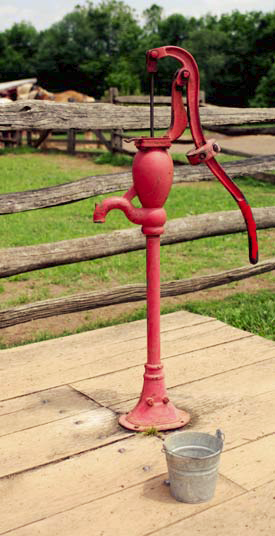
Whether you live in the city or country there is a good chance that at
least part of the water flowing from your faucets is groundwater or water
that originates in an underground aquifer. As Texans look to the future to
plan for water supplies to meet the needs of the state’s growing
population, groundwater is going to continue to play an important role.
The National Groundwater Association has dubbed March 11 through 17
National Groundwater Awareness Week, making this an ideal time to
look at ways we can take care of and conserve this most vital resource.
In Texas, 28 percent of the public drinking water supply, (about 1.2
million gallons a day) serving about 5.3 million people, comes from water
wells, according to statistics released by the Texas Groundwater
Protection Committee. And about 98 percent of rural Texans use
groundwater.
Even if your water does not come directly from underground, it may have
started there. Often, the water communities’ depend on for water supply
are fed by springs. Overall, aquifers supply about 60 percent of the water
used in Texas, including the 42 percent used for agriculture.
With the state’s population expected to nearly double in the next 50
years, we must act now to protect this valuable supply.
Here are some ways we all can help conserve and protect our groundwater:
Protection
While contaminants such as microorganisms and heavy metals occur naturally, there are many things we can
do to keep additional pollutants out of groundwater.
-
When using fertilizers on lawns, gardens and crops, follow the manufacturer’s instructions and avoid
using too much. In addition to potentially damaging your turf or plants, excess fertilizers, pest and
herbicides and other such substances can be washed in runoff into streams, lakes and environmentally
sensitive aquifer recharge areas.
-
Be careful when storing lawn chemicals, motor oil and other potentially hazardous substances
outdoors. Leaking containers or spills can pollute groundwater. Check with local authorities or waste
disposal services about safe ways to get rid of such unwanted materials. Often local agencies will hold
hazardous waste collection events. Click here to check for local hazardous household waste programs.
-
If you use a septic system, make sure it is properly installed and regularly maintained. Septic systems
must also be placed a safe distance from water bodies, wells and other areas where they could seep
into water supply. For more information about septic systems, their proper installation and regulations
in Texas, click here.
-
Old unused wells can be a quick path for pollutants to enter groundwater supplies as well as a public
safety hazard. The well is a direct route from the surface to the aquifer below, and contaminants can
enter with little or no filtration through soil and rocks as in other areas above groundwater. Plugging an
abandoned well by dumping materials into it until it is full may do little to reduce the potential for
contamination. The Texas Commission on Environmental Quality has a primer on properly plugging
wells, as well as other information, including relevant laws and regulations, here.
Conservation
According to the National Groundwater Association, Americans use 79.6 billion gallons of groundwater each
day. Just like with surface water, much of that is wasted due to poor personal habits. The good news is, there
is a lot we can do – easily — to greatly reduce the water we waste.
-
Indoors, one of the best things you can do to avoid wasting water is to check regularly for and fix
leaking faucets and toilets. Replace worn washers and valves on sinks and pipes. A leaking faucet can
waste more than 3,820 gallons of water a year.
- Run dish and clothes washers only when fully loaded. Consider buying higher-efficiency models.
-
When getting a drink, brushing teeth or doing the dishes, don’t leave the water running. Try scraping
plates over a trashcan or compost receptacle. Fill the sink with soapy water and rinse as needed. Put a
pitcher in the refrigerator for drinking water instead of running the sink to wait for it to cool. Wash fruits
and vegetables in a pan of water. Then, reuse the water on houseplants.
-
Outdoors, don’t over-water your lawn or garden. Water early in the morning when it is cool, to reduce
evaporation.
-
Use native grasses or others that require less water. Consider xeriscaping for landscaping, using
heartier, drought-tolerant plants instead of commonly used varieties that demand lots of water.
-
Considerer harvesting rainwater when the weather permits. Because rainwater is free of salts, minerals
and other contaminants, it is ideal for watering lawns and gardens, and with proper treatment, drinking.
Professional harvesting and storage containers are available on the market, ranging in size from small
buckets to tanks that can hold thousands of gallons.
For more information about conservation, rainwater harvesting, xeriscaping or other related topics, please visit
the Brazos River Authority’s Web site, by clicking here.